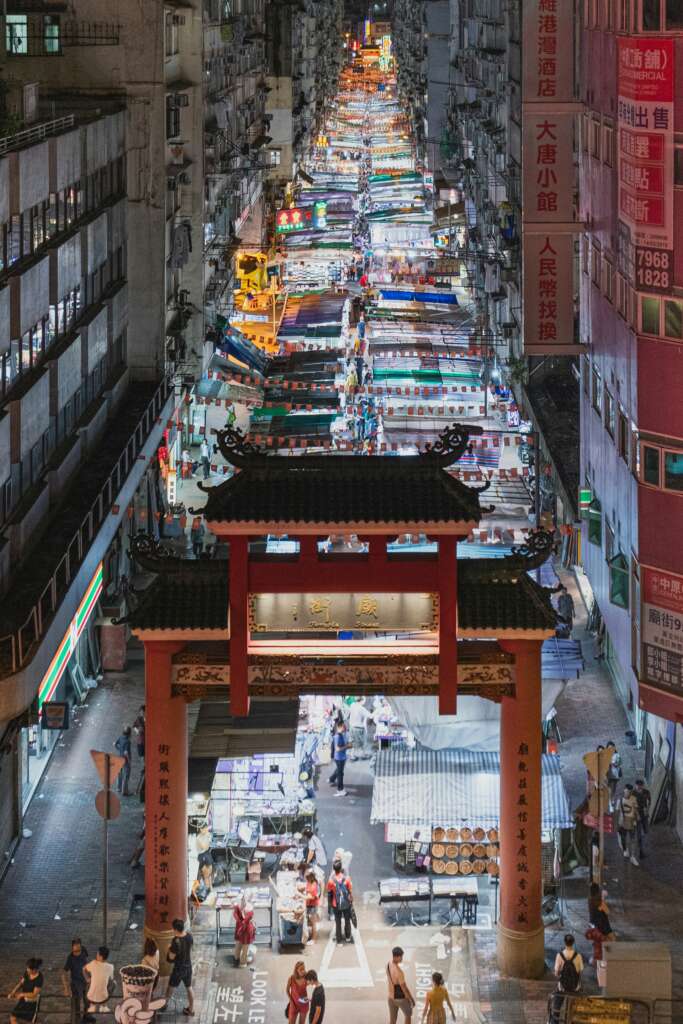HONG KONG’S TEMPLE STREET (廟街) market is buzzing again. This long, winding string of stalls, which actually crosses multiple streets, has been a popular shopping and eating spot for locals and tourists alike – and its long history means that it caters well for the nostalgic.
More than just a bustling street bazaar, the stalls, which stretch from Yau Ma Tei’s Kansu Street (甘肅街) to Jordan Road, have become a place that provides venues to many cultural activities of Hong Kong, from the devout worship of Goddess of the Sea Tin Hau (天后), to visiting fortune-tellers, to shopping fans picking over a plethora of merchandise, to stall holders displaying kitschy souvenirs, to street chefs providing delicious stir-fried and seafood cuisines.

The name comes from iconic Tin Hau Temple (天后廟) near Public Square Street (眾坊街). As Hong Kong was a fishing village, the temple built in the 1860s in Yau Ma Tei – where was once close to the harbour front – as a divine place for fishermen to pray for safe voyage.

There is a legend that Tin Hau, also named Ma Tsu (媽祖), came from a fishing family in the Song dynasty, and had the divine power to predict the weather. She become a guardian of those fishermen caught in storms. Tin Hau is now believed to be able to grant good wishes and get rid of evil spirits in Hong Kong.
In Chinese society, there is a traditional practice that some local parents have made a ritual ceremony to let their newborn babies and children be devoted to Tin Hau – as the deity’s sons and daughters, they can enjoy a blessing that will give them a positive fate.

Also, the Kwun Yum Temple (觀音廟) which was built in more than a century ago and is close to Tin Hau Temple, is also iconic. Kwun Yum, AKA the Goddess of Mercy, AKA Guanyin, offers sympathy and compassion which have made her a widely revered deity in Hong Kong.
A CENTURY OF HISTORY
In the 1920s, a hectic bazaar was established in an open space near the Tin Hau Temple. Known as Yung Shu Tau (榕樹頭), which means banyan tree stump, there were numerous stalls which sold daily necessities, Chinese medical oil, clothes, and food such as snake soup in the evenings under the shade of giant banyan trees.

Also, many entertainers gathered in the bazaar as night fell to amaze audiences with exhilarating juggling and martial arts performances as well as Cantonese Opera shows.

There were also fortune-tellers who tried to help their customers find out their fate via palm reading and other ways. One of the famous methods resorts to bird fortune-telling (靈雀占卜) – when a bird comes out from a cage and selects a card randomly on which clients’ fortune would be written. While people may think it is superstition, fortune-telling is an inalienable part of Hong Kong culture.

In the late 1970s, the authorities decided to build a community centre nearby Yung Shu Tau. The government relocated all the hawkers’ stalls and provided them licenses to operate their businesses on Temple Street, an arrangement that continues today.
There are still some fortune-tellers’ stalls on Temple Street to give guidance and inspiration for those who want to divine their future.
PRINCE OF TEMPLE STREET
Since the 1970s, renowned singer Jackson Wan Kwong (尹光) has brought laughter to Hong Kong people with his classic songs, often featuring ribald lyrics.

Aged 79, Wan is an icon of Hong Kong and recently started getting many younger fans. His songs range from classical to Chinese opera – but he is best known for his suggestion lyrics.
One of his classic songs is “Hollywood Grand Hotel” (荷里活大酒店), which depicts tale of three fat ladies playing ball near a grand hotel.
Wan, who was born in Vietnam and came to Hong Kong to rise to local stardom, has never actually performed on Temple Street, but is hailed as “The Prince of Temple Street” because of his street-level popularity. He was at the height of his fame in the 1970s and 1980s, and still occasionally performs.
Wan’s songs touch on taboo subjects ranging from sex and anti-filial piety, forming a core memory for many Hong Kong people.
SHOPPING AND DELICACIES
Meanwhile, Temple Street is a place where many locals and tourists delve into budget-friendly shopping in the evenings. Hawkers on the street sell a wide range of low-priced items. Visitors can buy anything from watches, clothes, antiques, household items, electronic products, smartphone accessories and much more.

Some food stalls and dai pai dongs (大牌檔) provide delicious food such as claypot rice (煲仔飯) and a variety of dishes and seafood cuisine. Signature dishes include salt and pepper squid (椒鹽魷魚) and steamed shrimp with garlic and vermicelli (蒜茸粉絲蒸蝦)。

Apart from dai pai dong eateries, there are cha chaan teng (茶餐廳) restaurants, too, such as Mido Cafe (美都餐室) on Temple Street. With its memory-evoking mosaic floors, it offer signature baked pork chops, iced red bean drinks and milk tea.

Currently, Temple Street has ushered in momentum on its night vibes. Starting from last December, dozens of street food stalls have been established for visitors and tourists to taste local, Southeast Asian and overseas snacks and drinks.

Temple Street is a world-famous street and travellers and tourists who visit Hong Kong always head to Kowloon to visit this evenings-only shopping area. The street is a fusion of the old and new Hong Kong. You can get your fortune told in the ancient fashion – and then pick up some up-to-the-moment accessories for your mobile phone.
Image at the top by Hong Kong Tourism Board
